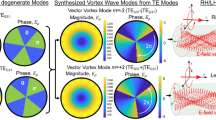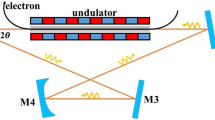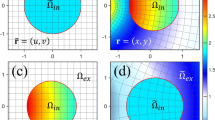Abstract
In this paper, influence of InP coupling cavity on Fano resonance of sub wavelength MIM waveguide was studied by FDTD. It was observed that the resonant wavelengths of mode mj (j = 1, 2, 3) were closely related with the height H2 of InP coupling cavity. In addition, before and after the addition of air cavity, the relative farfield intensities I was a function of height H2. Therefore, InP as discrete state could be used as the filling dielectrics of Fano resonance in the MIM waveguide.
Similar content being viewed by others
Introduction
Due to its attractive features and extensive applications, the metal–insulator–metal (MIM) waveguide1,2,3,4,5 were very popular with researchers. During the process of light propagation in the nano-photonic circuits, MIM waveguides could reduce energy loss. The MIM waveguide with coupling cavity could change its filtering performance6,7,8,9, such as Fano resonance. The most common structures with the filters were MIM waveguides with a rectangular cavity10,11,12,13,14. Silicon was used as filter dielectrics in the coupling cavity13,14. Due to relatively large dielectric constant and high-order resonance about 1700 nm in the near-infrared region, silicon was usually regarded as discrete state of Fano resonance13,14,15,16,17,18. In the study, obvious Fano resonance could be observed when InP was chose as the dielectrics in the coupling cavity of MIM waveguide. Namely, InP could also be used as discrete state of Fano resonance. In this paper, InP19,20,21,22,23,24,25 would be used as the filling dielectrics in the MIM waveguide cavity and the influence of InP coupling cavity on Fano resonance of sub wavelength MIM waveguide (Ag-Air-Ag) was explored on the basis of the literatures22,25,26.
Results
The sketch of the waveguide structure designed was shown in Fig. 1. In the figure, the distance w of the main waveguide cavity with the transparent dielectrics (n = 1.0) was set as 50 nm which was far less than the wavelength λ of incident wave so that SPPs propagation mode could be excited in MIM waveguide structure because the number of SPP modes was closely related to the distance along the wave propagation direction27. In addition, the width L of the coupled cavities was also set as 50 nm. Our simulation results indicated that Fano resonance was independent of the horizontal distance between the two cavities and dependent on the height H1 (H2). Additionally, the relative far-field intensity I was defined as the area under the far-field curve and was proportional to the height h of the curve in this paper.
Figure 2a showed the transmission spectra under different InP structures without air cavity A. It could be observed that the resonance peaks of mode mj (j = 1, 2, 3) redshifted with the increase of H2 from 240 to 350 nm. And that the resonant wavelengths were a function of the height H2. Take H2 = 350 nm as an example, it could be observed three resonance valleys at about 998 nm, 1302 nm and 2079 nm, respectively. The resonance valleys at 1302 nm and 2079 nm were considered to be first and second order resonance modes, shown in Fig. 2c,d. However, the resonance valley at 998 nm was regarded as third-order resonance (seen in Fig. 2a,b), which was independent of the height H1 and closely related to the height H2 according to our simulations. In other words, the resonance mode in Fig. 2a could directly be confirmed by the distribution of magnetic field in Fig. 2b–d.
When the zero order dark mode from the Air cavity and j-order bright modes (j = 1, 2 and 3) from the InP cavity were superimposed, some Fano resonance of the modes mj (j = 1, 2 and 3) could be obtained in Fig. 3a, which showed the transmission spectra of different InP-Air structures. In the case of only air cavity, the transmission spectrum was very wide passband, which covered the resonance wavelengths of the modes mj (j = 1, 2 and 3) and whose central wavelength was lied at about 1710 nm. For the mode m1, more obvious Fano resonance was observed when H2 = 240 nm and 260 nm. However, the most obvious Fano resonance came from the mode m2 whose resonance valley shifted to the long wavelength with the H2 increase. According to the main resonance peak22,23,23 of the mode m2 in the Fig. 3a, the quality factor (QF) and the extinction ratio (ER) could be calculated19,20,23,26. The quality factor Q was defined as the ratio of the resonance wavelength λ0 and the full width Δλ between the peak and the antipeak of the transmission (Q = λ0/Δλ). The extinction ratio (Ext) was ten times the logarithm of the ratio of the maximum transmission light intensity P to the minimum transmitted light intensity P0, namely, Ext = 10lg(P/P0). A high-quality factor meant lower light energy loss in a resonant cavity. Moreover, the lager extinction ratio was implied the better quality of the resonator. For the different InP-Air structures with the length H2 from 240 to 350 nm (240 nm, 260 nm, 280 nm, 300 nm, 320 nm and 350 nm), the quality factor QFs calculated were about 44, 30, 29, 28, 34 and 37, respectively. The ERs obtained were around 13, 18, 15, 14, 31 and 12 dB, respectively. These results showed that the QFs and the ERs were a function of the height H2. There was lower light energy loss in a resonant cavity and better quality of the resonator for the length H2 = 240 nm and 320 nm. In other words, when the height H2 was not higher than 240 nm and not less than 320 nm, the waveguide structure with InP-Air cavities had good filtering performance. In addition, it was obtained that the addition of air cavity did not change the resonant position which was dependent on structure sizes of the cavity InP. Take H2 = 350 nm as an example, for the three resonance valleys at 998 nm, 1302 nm and 2079 nm, it was observed the magnetic field distribution did not change before and after the addition of air cavity. Additionally, it was obtained that the magnetic field distribution of the zero-order resonance in the air cavity, as shown in Fig. 3b–d.
(a) The relationship between Fano resonance and the height H2 in the range from 780 to 1800 nm. (b–d) Magnetic field distribution of different modes at different resonance wavelengths 998 nm, 1302 nm and 2079 nm, respectively. Red and blue represent two different vibrations. The structural parameter was H1 = 300 nm.
Before the addition of air cavity, under 1302.87 nm monitoring, the relative farfield intensities I varied with the height H2 from 240 to 350 nm and was a function of height H2, namely, I = I(H2), as shown in Fig. 4a. The shape of the curve was Guassian Spot with periodic structure, whose symmetric center was located at about θ = − 2.2°, as shown in the black dash. The relative farfield intensity I gradually decreased with the height H2 from 260 to 350 nm. The maximum relative intensity I(260) was about three times that of the minimum I(350), I(260) = 3I(350). After the addition of air cavity, it was observed that the relative farfield intensities I was also a function of height H2, as shown in Fig. 4b. The symmetric center of the curve with periodic structure was located at about θ = 0°, as seen in the black dash. The relative farfield intensity I gradually increased with the height H2 from 240 to 320 nm. The maximum relative intensity I(320) was about four times that of the minimum I(350), namely, I(320) = 4I(350). Therefore, the change of structural parameters could be obtained according to the change of far-field relative intensity20.
Discussion
Influence of InP coupling cavity on Fano resonance of sub wavelength MIM waveguide was studied in this paper. Some novel results were obtained. For different InP structures without air cavity, it was observed the resonance peaks of mode mj (j = 1, 2 and 3) redshifted with H2 increase and the resonant wavelengths of mode mj (j = 1, 2 and 3) were a function of the height H2. For the different InP-Air structures with the length H2 from 240 to 350 nm, the resonance valley of the mode m2 shifted to the long wavelength. In addition, before and after the addition of air cavity, the relative farfield intensities I was a function of the height H2. Therefore, InP as discrete state of Fano resonance could be used as the filling dielectrics of Fano resonance in the MIM waveguide.
Methods
Numerical simulations
In the letter, the MIM plasmonic waveguide coupled with InP cavity was investigated using the finite-difference time-domain (FDTD, Lumerical Computational Solutions Incorporation) with a perfectly matched layer absorbing boundary condition. A plane wave with the electric field parallel to the x axis illuminates normally the periodic structure. The grid sizes in the x and y directions were 2 nm.
References
Törmä, P. & Barnes, W. L. Strong coupling between surface plasmon polaritons and emitters: A review. Rep. Prog. Phys. 78, 013901. https://doi.org/10.1088/0034-4885/78/1/013901 (2015).
Abdol, S. O. et al. Tunable surface plasmon polaritons in a Weyl semimetal waveguide. J. Phys. Condens. Matter 31, 335002. https://doi.org/10.1088/1361-648X/ab217f (2019).
Lošić, ŽB. Surface plasmons in Weyl semimetals. J. Phys. Condens. Matter 30, 365003. https://doi.org/10.1088/1361-648X/aad6f5 (2018).
Saleh, N. M. & Aziz, A. A. Simulation of surface plasmon resonance on different size of a single gold nanoparticle. J. Phys. Conf. Ser. 1083, 012041. https://doi.org/10.1088/1742-6596/1083/1/012041 (2018).
Cao, E. et al. Exciton–plasmon hybrids for surface catalysis detected by SERS. Nanotechnology 29, 372001. https://doi.org/10.1088/1361-6528/aacec4 (2018).
Melentev, G. A. et al. Surface plasmon-phonon polaritons in GaAs. J. Phys. Conf. Ser. 917, 062038. https://doi.org/10.1088/1742-6596/917/6/062038 (2017).
Kim, Y. et al. Demonstration of integrated polarization rotator based on an asymmetric silicon waveguide with a trench. J. Opt. 18, 095801. https://doi.org/10.1088/2040-8978/18/9/095801 (2016).
Ghosh, S. et al. Transverse localization of light in 1D disordered waveguide lattices in the presence of a photonic bandgap. Laser Phys. 24, 045001. https://doi.org/10.1088/1054-660X/24/4/045001 (2014).
Piccione, B. et al. Tailoring light–matter coupling in semiconductor and hybrid-plasmonic nanowires. Rep. Prog. Phys. 77, 086401. https://doi.org/10.1088/0034-4885/77/8/086401 (2014).
Wen, K. et al. Wavelength demultiplexing structure based on a plasmonic metal–insulator–metal waveguide. J. Opt. 14, 075001. https://doi.org/10.1088/2040-8978/14/7/075001 (2012).
Sheng, Y. et al. Fabrication of lateral electrodes on semiconductor nanowires through structurally matched insulation for functional optoelectronics. Nanotechnology 24, 025204. https://doi.org/10.1088/0957-4484/24/2/025204 (2013).
Yun, B., Hu, G. & Wei, C. J. Plasmon induced transparency in metal–insulator–metal waveguide by a stub coupled with F-P resonator. Mater. Res. Express 1, 036201. https://doi.org/10.1088/2053-1591/1/3/036201 (2014).
Zhong, X. & Li, Z. Plasmon enhanced light amplification in metal–insulator–metal waveguides with gain. J. Opt. 14, 055002. https://doi.org/10.1088/2040-8978/14/5/055002 (2012).
Wang, Y. & Yan, X. Mode conversion in metal–insulator–metal waveguide with a shifted cavity. Jpn. J. Appl. Phys. 57, 010303 (2018).
Zheng, G., Su, W. & Chen, Y. Band-stop filters based on a coupled circular ring metal–insulator–metal resonator containing nonlinear material. J. Opt. 14, 055001. https://doi.org/10.1088/2040-8978/14/5/055001 (2012).
Nurmohammadi, T. et al. Ultra-fast all-optical plasmon induced transparency in a metal–insulator–metal waveguide containing two Kerr nonlinear ring resonators. J. Opt. 20, 055504. https://doi.org/10.1088/2040-8986/aab882 (2018).
Yun, B., Hu, G. & Cui, Y. Theoretical analysis of a nanoscale plasmonic filter based on a rectangular metal–insulator–metal waveguide. J. Phys. D Appl. Phys. 43, 385102 (2010).
Li, S., Liu, H. & Liu, L. Effect of silver film thickness on the surface plasma resonance in the rectangular Ag–Si–SiO2 cavity. J. Phys. Commun. 2, 055024. https://doi.org/10.1088/2399-6528/aac52e (2018).
Li, S. et al. Investigation of surface plasmon resonance in the rectangular cavity of Ag–Si–SiO2. Plasmonics 13(6), 2313. https://doi.org/10.1007/s11468-018-0754-y (2018).
Li, S. et al. Farfield under small scattering angle in the rectangular Ag–Si–SiO2 cavity. Plasmonics 14, 1385. https://doi.org/10.1007/s11468-019-00928-7 (2019).
Ghorbani, S., Dashti, M. A. & Jabbar, M. Plasmonic nano-sensor based on metal-dielectric-metal waveguide with the octagonal cavity ring. Laser Phys. 28, 066208. https://doi.org/10.1088/1555-6611/aab463 (2018).
Mao, J. et al. Numerical analysis of near-infrared plasmonic filter with high figure of merit based on Fano resonance. Appl. Phys. Express 10, 082201. https://doi.org/10.7567/APEX.10.082201 (2017).
Zhang, S., Li, G. & Chen, Y. Pronounced fano resonance in single gold split nanodisks with 15 nm split gaps for intensive second harmonic generation. ACS Nano 10, 11105–11114. https://doi.org/10.1021/acsnano.6b05979 (2016).
Ren, D. K., Farrell, C. A., Diana, L. & Huffaker, L. Axial InAs(Sb) inserts in selective-area InAsP nanowires on InP for optoelectronics beyond 2.5 µm. Opt. Mater. Express 8(4), 1075–1081. https://doi.org/10.1364/OME.8.001075 (2018).
Bekele, D. A. et al. Optical time domain demultiplexing using fano resonance in InP photonic crystals. In The European Conference on Lasers and Electro-Optics, Paper CK_1_5 (2017).
Li, S. et al. Fano resonance of air-Si waveguide cavity. Plasma Res. Express 2(4), 045005. https://doi.org/10.1088/2516-1067/abc467 (2020).
Li, H. et al. Graphene-based mid-infrared, tunable, electrically controlled plasmonic filter. Appl. Phys. Express 7, 024301. https://doi.org/10.7567/APEX.7.024301 (2014).
Acknowledgements
This work was supported by the National Natural Science Foundation of China (Grant No. 51571088) and the Natural Science Foundation of Hunan Province (No. 2019JJ40535).
Author information
Authors and Affiliations
Contributions
J.J.M. designed the Fig. 1. S.H.B. made a simulation according to the design and processed the pictures of the simulated magnetic field (Figs. 2b–d, 3b–d) by using drawing software. H.Q.L made the figures (Figs. 2a, 3a, 4a,b) by using OriginPro 9.0 according to the simulated data and participated in the analysis and interpretation of all figures. All the authors participated in the writing of the article. S.F.X. and J.L. provided financial support.
Corresponding authors
Ethics declarations
Competing interests
The authors declare no competing interests.
Additional information
Publisher's note
Springer Nature remains neutral with regard to jurisdictional claims in published maps and institutional affiliations.
Rights and permissions
Open Access This article is licensed under a Creative Commons Attribution 4.0 International License, which permits use, sharing, adaptation, distribution and reproduction in any medium or format, as long as you give appropriate credit to the original author(s) and the source, provide a link to the Creative Commons licence, and indicate if changes were made. The images or other third party material in this article are included in the article's Creative Commons licence, unless indicated otherwise in a credit line to the material. If material is not included in the article's Creative Commons licence and your intended use is not permitted by statutory regulation or exceeds the permitted use, you will need to obtain permission directly from the copyright holder. To view a copy of this licence, visit http://creativecommons.org/licenses/by/4.0/.
About this article
Cite this article
Ban, S., Liu, H., Xiao, S. et al. Influence of InP coupling cavity on Fano resonance of sub wavelength MIM waveguide. Sci Rep 11, 11633 (2021). https://doi.org/10.1038/s41598-021-90773-8
Received:
Accepted:
Published:
DOI: https://doi.org/10.1038/s41598-021-90773-8
Comments
By submitting a comment you agree to abide by our Terms and Community Guidelines. If you find something abusive or that does not comply with our terms or guidelines please flag it as inappropriate.







